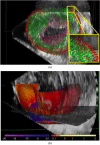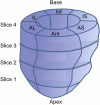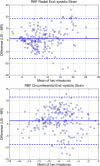Radial basis functions for combining shape and speckle tracking in 4D echocardiography
- PMID: 24893257
- PMCID: PMC4283552
- DOI: 10.1109/TMI.2014.2308894
Radial basis functions for combining shape and speckle tracking in 4D echocardiography
Erratum in
-
Correction to "Radial Basis Functions for Combining Shape and Speckle Tracking in 4D Echocardiography".IEEE Trans Med Imaging. 2015 Feb;34(2):690. doi: 10.1109/TMI.2015.2397791. IEEE Trans Med Imaging. 2015. PMID: 25647814 Free PMC article. No abstract available.
Abstract
Quantitative analysis of left ventricular deformation can provide valuable information about the extent of disease as well as the efficacy of treatment. In this work, we develop an adaptive multi-level compactly supported radial basis approach for deformation analysis in 3D+time echocardiography. Our method combines displacement information from shape tracking of myocardial boundaries (derived from B-mode data) with mid-wall displacements from radio-frequency-based ultrasound speckle tracking. We evaluate our methods on open-chest canines (N=8) and show that our combined approach is better correlated to magnetic resonance tagging-derived strains than either individual method. We also are able to identify regions of myocardial infarction (confirmed by postmortem analysis) using radial strain values obtained with our approach.
Figures











References
-
- Murray CJ, Jamison DT, Lopez AD, Ezzati M, Mathers CD. Global Burden of Disease and Risk Factors. World Bank, Oxford Univ. Press; Washington, DC: 2006. - PubMed
-
- Kramer C, Rogers W, Theobald T, Power T, Petruolo S, Reichek N. Remote noninfarcted region dysfunction soon after first anterior myocardial infarction. Circulation. 1996;94:660–666. - PubMed
-
- Marcus JT, Götte MJ, Van Rossum AC, Kuijer JP, Heethaar RM, Axel L, Visser CA. Myocardial function in infarcted and remote regions early after infarction in man: Assessment by magnetic resonance tagging and strain analysis. Magn. Reson. Med. 1997 Nov.38:803–810. - PubMed
-
- Kramer CM, Lima JA, Reichek N, Ferrari V. a., Llaneras MR, Palmon LC, Yeh IT, Tallant B, Axel L. Regional differences in function within noninfarcted myocardium during left ventricular remodeling. Circulation. 1993 Sep.88:1279–1288. - PubMed
-
- Bohs LN, Trahey GE. A novel method for angle independent ultrasonic imaging of blood flow and tissue motion. IEEE Biomed. Eng. 1991 Mar.38(3):280–286. - PubMed
Publication types
MeSH terms
Grants and funding
LinkOut - more resources
Full Text Sources
Other Literature Sources

